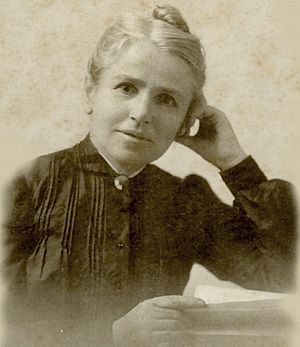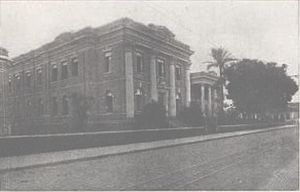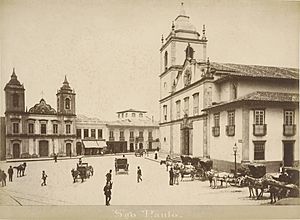Marie Rennotte facts for kids
Quick facts for kids
Marie Rennotte
|
|
|---|---|

Rennotte around 1900–1910
|
|
| Born |
Jeanne Françoise Joséphine Marie Rennotte
11 February 1852 Souverain-Wandre near Liège, Belgium
|
| Died | 21 November 1942 (aged 90) São Paulo, Brazil
|
| Nationality | Belgian Brazilian |
| Other names | Marie Renotte |
| Occupation | Physician, teacher, women's rights activist |
| Years active | 1875–1935 |
Marie Rennotte (born February 11, 1852 – died November 21, 1942) was an important figure in Brazil. She was born in Belgium but became a Brazilian citizen. Marie was a doctor, a teacher, and a strong supporter of women's rights. She worked hard to improve education and healthcare for women.
After becoming a teacher in Belgium and France, Rennotte taught in Germany for three years. In 1878, she moved to Rio de Janeiro, Brazil, to work as a governess. She gave private lessons and taught at a girls' school until 1882. Then, she moved to Piracicaba in the State of São Paulo. From 1882 to 1889, she taught science at the Colégio Piracicabano. She also helped create the school's lessons and made it very well-known. This school was special because it offered equal education to both girls and boys.
In 1889, Marie Rennotte received a scholarship from the State of São Paulo. She used it to study medicine at the Woman's Medical College of Pennsylvania in Philadelphia, USA. That same year, she became a Brazilian citizen. This happened because a new law allowed foreigners living in Brazil permanently to become naturalized. She finished medical school in 1892. From 1893 to 1895, she studied at the Paris Hôtel-Dieu Hospital. There, she specialized in obstetrics and gynaecology, which is about childbirth and women's health.
When she returned to Brazil, she had to defend her medical thesis. This was to make sure her degree was valid in Brazil. She successfully defended it at the University of Rio de Janeiro. This allowed her to practice medicine in the country. From 1895 to 1899, Rennotte led the maternity unit at the Maternity Hospital of São Paulo. She helped patients in the hospital and delivered babies in private homes. After leaving the hospital, she opened her own clinic. She also ran a special clinic for poor people and immigrants, while still seeing patients who could pay.
In 1901, she joined the São Paulo branch of the Brazilian Historic and Geographic Institute. From 1906 to 1910, she researched how chloroform worked as an anesthetic. She then traveled to Europe to learn how to start a Red Cross branch in São Paulo. She founded the local Red Cross branch in 1912. She also opened a school to train nurses and started a campaign to build the first children's hospital in São Paulo. Marie Rennotte continued to practice medicine until the mid-1920s. Later, she became more involved in the international feminist movement and science meetings. In 1922, she founded the Paulistan Alliance for Women's Suffrage. This group worked for women's right to vote. By the late 1930s, she was very ill, blind, and deaf. She received a state pension until she passed away in 1942. People remember her for her efforts to improve women's education, healthcare, and their rights to work and be citizens. She also helped shape feminist ideas in Brazil in the 1800s.
Contents
Early Life and Education
Marie Rennotte was born on February 11, 1852, in Souverain-Wandre, near Liège, Belgium. In 1873, she graduated from the Normal School of Liège. She continued her studies in Paris, France. In 1874, she earned a certificate to teach elementary school. The next year, she passed the exam needed to start teaching in France.
Career Highlights
Teaching in Brazil
After getting her teaching certificate, Rennotte taught French in Mannheim, Germany, for three years. In May 1878, she arrived in Rio de Janeiro, Brazil. She worked as a governess and taught at private schools, including the Colegio Werneck. There, she taught drawing, French, German, and writing.
In 1882, she was hired by Martha Watts, a missionary from Kentucky. Marie Rennotte went to Piracicaba to teach at the new Colégio Piracicabano. This girls' boarding school was very modern for its time. It focused on giving girls a full education, not just preparing them for home life. The school believed in co-education, meaning boys and girls learned together. It offered many subjects, including languages, math, philosophy, and sciences.
Marie Rennotte's teaching methods were new for Brazil. She didn't want students to just memorize facts. Instead, she asked them to think and give complete answers. She taught French, anatomy, chemistry, physics, geography, and history. She also started a literary club and a natural history museum. The school's goal was to prepare students for higher education, like normal schools or universities.
The Colégio Piracicabano faced opposition from groups who wanted traditional education for women. Because Martha Watts didn't speak Portuguese well, Rennotte became the school's voice. She wrote articles defending their teaching methods in local newspapers. She also wrote about women's illiteracy and how customs kept women at home. She argued that educating women was key to preparing children for their roles as citizens.
In 1886, Rennotte traveled to the United States and France to study new teaching ideas. When she returned in 1887, the school faced a challenge. An education inspector said the school's co-education and lack of Catholic religious teaching broke the law. But the state government allowed the school to continue. Rennotte then started offering night classes in chemistry and physics for anyone who wanted to learn. In 1888, she began working with Josefina Álvares de Azevedo, who started a feminist magazine called A Família. Rennotte wrote articles saying that women's lack of education was like slavery. She believed educating women was vital for society.
Becoming a Doctor
In 1889, Marie Rennotte went to the World Fair in Paris. After a short trip back to Brazil, she went to the United States in June. She enrolled in the Woman's Medical College of Pennsylvania in Philadelphia to study medicine. She received a scholarship from Prudente Morais Barros, who was the governor-elect of São Paulo. In December of that year, she became a Brazilian citizen.
She graduated in 1892, becoming the first woman from São Paulo to earn a medical degree. From 1893 to 1895, Rennotte studied at the Hôtel-Dieu Hospital in Paris. She completed her training in obstetrics and gynaecology, focusing on childbirth, women's health, and even neonatology (newborn care).
Medical Practice and Social Work
Marie Rennotte returned to Brazil in 1895. On March 26, she defended her thesis, Influence of women's education on social medicine. Her thesis discussed how social customs affected women's health. For example, doctors often avoided talking about women's bodies. Also, fashion trends like tight corsets and small shoes were harmful. She successfully got her diploma recognized in Brazil. Soon after, she joined the Society of Medicine and Surgery of São Paulo.
Rennotte started working at the Maternity Hospital of São Paulo. She was the director and helped patients in the hospital and at home. She raised money for the hospital and created special wards for surgical patients and poor women. She also kept writing articles about women's health. In June 1899, she left the Maternity Hospital to focus on research and community work.
Marie Rennotte opened a clinic in her home near the Praça da Sé. There, she gave medicines to poor people and immigrants. She became very popular and was invited to speak at medical conferences. In 1901, she joined the São Paulo branch of the Brazilian Historic and Geographic Institute. She also became a partner in the Benevolent Medical Association in 1905. This group was run by Arnaldo Vieira de Carvalho, a famous Brazilian doctor. In 1905, she also joined the Women's Benevolent and Instructive Association. This group, founded by Anália Franco, helped poor and working women. They created nurseries, schools, and training workshops.
In 1906, Rennotte researched the effects of chloroform as an anesthetic. She presented her findings in 1910. Around the same time, she was asked to go to Europe to learn about organizing the Brazilian Red Cross. After visiting Red Cross places in France and Germany, Rennotte returned to São Paulo. She founded the São Paulo branch of the Brazilian Red Cross on October 5, 1912.
That same year, she opened a Practical Nursing School. It offered classes for professional nurses, volunteers, and first aid. Rennotte also pushed for a children's hospital. She started a campaign asking students and wealthy citizens to donate a small amount of money each month. By 1918, land was donated, money was raised, and construction began on the Hospital de Crianças (Infants' Hospital). This was the first children's hospital in Brazil.
During World War I, Rennotte trained Red Cross volunteers. During the 1918 flu pandemic, she traveled across São Paulo. She provided medical help and support. She received an award from Prussia for her efforts.
In 1922, she attended the First International Feminist Congress in Rio de Janeiro. This congress was organized by a group working for women's progress. Carrie Chapman Catt, a famous women's suffrage leader, attended. She went to São Paulo with Rennotte to help her found the Paulistan Alliance for Women's Suffrage. Rennotte was elected a vice president of this group.
When many people were injured during the Paulista Revolt of 1924, she set up a hospital ward in a theater. This was because the hospitals didn't have enough beds. She continued to be active in science conferences and community groups until 1935. In 1938, she was granted a lifetime pension because she was poor and had lost her sight and hearing.
Death and Legacy
Marie Rennotte passed away on November 21, 1942, in São Paulo. She was buried in the Cemitério dos Protestantes. Even though war news filled the papers, her death was reported for several days. Important people in society wrote about her life.
She is remembered for her work to improve women's education and healthcare. She also fought for women's rights to work and be citizens. From 1882 to 1925, Rennotte wrote many articles. These articles were about helping others, education, medicine, and women's issues. She, along with other writers, helped shape feminist ideas in Brazil during the 1800s.
In the 1960s, the Hospital de Crianças in São Paulo became part of a larger hospital network. It was used to train pediatric doctors until 1983. In 2001, Nelly Martins Ferreira Candeias, the first woman president of the Historic and Geographic Institute of São Paulo, honored Rennotte. This was to celebrate 100 years since Rennotte joined the organization.
See also
 In Spanish: Marie Rennotte para niños
In Spanish: Marie Rennotte para niños




